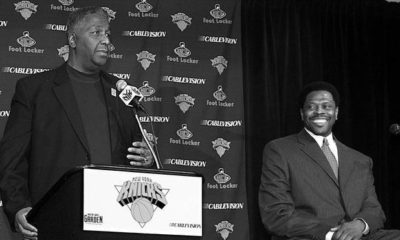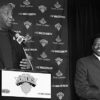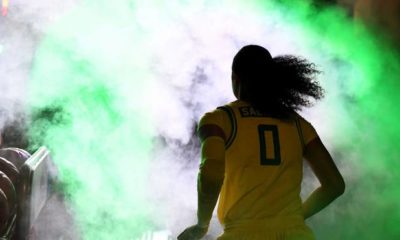US-Sport
NFL: Third and Long: Draft Nuggets and Trends in the NFL
After draft degrees and the power ranking after draft and free agency, SPOX editor Adrian Franke looks back on the draft one last time in his column: Where are some exciting position groups to be found now? What trends can be identified, what conclusions can the draft draw on tactics and approaches in the NFL?
You want to ask questions to the SPOX-NFL column? This goes directly to the author!
Green Bay’s defense last season was not good – in particular: The secondary was not good. As far as the Adjusted Sack Rate and the total number of sacks were concerned, the Packers League average and also the Linebacker Corps did a good job.
The main reason why the pass defense was once again one of the worst in the league and Green Bay was one of the worst teams in the NFL, in addition to the play calling of defensive coordinator Dom Capers, especially in critical moments – especially with regard to opposing third down conversions and red zone scoring efficiency.
This should now come to an end.
The Packers not only have a new Defensive Coordinator in Mike Pettine, who will advance the defense with a more variable front and more aggressive play calling – the draft has also massively advanced the Packers individually. Jaire Alexander was one of the most aggressive cornerbacks in the draft and could start directly in the slot – depending on how far last year’s more physical rookie Kevin King is.
In addition, Green Bay secured the most aggressive route-anticipating cornerback in this draft class with Josh Jackson in round two. Jackson fell much deeper than expected, his style often reminds of Marcus Peters. In Green Bay he can learn something behind free agent Tramon Williams, who had some very good games in Arizona last year. With his ball hawking skills, however, he could quickly become a turnover magnet in Pettines Defense.
The packers will build on an aggressive, flexible front combined with attacking secondary, and the fans in Green Bay can look forward to a whole new feeling on this side of the ball.
We have seen it again several times in this draft: Above all, good, already comparatively complete teams invest in positions where they are already well filled – and thus pick value over need on the one hand, on the other they also secure themselves for possible departures in the future.
These include the Jaguars, who secured another defensive tackle with Taven Bryan in the first round. Or the Minnesota Vikings with cornerback Mike Hughes in round 1 and Philadelphia (D-Liner Josh Sweat) in this category, just like the Atlanta Falcons.
Nobody had the Falcons with a wide receiver on the screen in the first round, a defensive tackle might have been the more sensible way. However, the value with Calvin Ridley at position 26 is indisputable: A very good route runner, the clear number 1 in the class in this respect. Also an explosive receiver with smooth movements, balance and a good understanding of the game. In short: a very good addition to Julio Jones and Mohamed Sanu.
The Falcons Offense becomes a matchup nightmare for defenses. With Devonta Freeman and Tevin Coleman the Falcons have perhaps the most flexible running back duo in the NFL, both backs are dangerous as runners and receivers. Rookie Ito Smith adds another weapon as receiver, the offensive line should still belong league-wide at least in the upper half.
Ridley should start directly in the slot, but Atlanta can now, depending on the strength of the Defense, Jones, Sanu and Ridley, attack different areas of the field at different depths.
The cowboy opener last season had many problems. From play calling to offensive line injuries, weaknesses in the receiving corps, inconstant performances by Dak Prescott to, of course, Ezekiel Elliott’s suspension – the causes were many and varied.
No problem? The run blocking. Football Outsiders lists the cowboys in fourth place for adjusted line yards (including down, distance to first down, opponents and the question of shotgun or under-center formation), the running backs of only three teams were stopped less frequently on or in front of the line of scrimmage than the cowboy backs and Dallas in third and fourth down in short yardage situations.
As a result, it is no coincidence that the cowboys ranked third in the league with 4.5 yards per run in the past Regular Season, despite the long Elliott ban. The run blocking was so strong – and the overall run game should improve again in the coming season.
Dallas managed a potential steal with Connor Williams in the second round. The Texas tackle could be tried as a right tackle on the cowboys, which would allow La’el Collins to continue playing left guard – Collins is much stronger here than on the right tackle spot. If that succeeds, the line from left to right with Tyron Smith, La’el Collins, Travis Frederick, Zack Martin and Connor Williams would be by far the best occupied line of the NFL.
In addition, the cowboys have made a backup for Elliott in round seven, who will physically challenge opposing defenses in the fourth quarter. Alabama’s Bo Scarbrough is a runner with dangerous power and physique who has a strong inside burst and pulls out yards after enemy contact. The offensive line in combination with the Elliott/Scarbrough combination will be the heart of this cowboys team.
The Broncos Super Bowl team three years ago defined itself through an outstanding defense. While Brock Osweiler and the rapidly sloping Peyton Manning were switched on the offensive, the Defense carried Denver to triumph. At the centre: A spectacular cornerback trio in combination with the best pass Russian quartet in the NFL.
After the draft, Denver could be on his way back – at least. With Bradley Chubb across from Von Miller, the Broncos pass rush is ready for the quarterback hunting season. Denver can set up Chubb flexibly and has with Shane Ray and Shaquil Barrett next to him as well as Derek Wolfe in the defensive line the lowest pass rush at this level and with this quality in the NFL.
Rotation in the defensive line and explicitly in the pass rush can be an incredibly powerful weapon, within a season as well as within a game. The Broncos should let Chubb – who is already an excellent run defender in any case – start directly and then have the freedom to rotate on very high level during passing downs.
Should third round cornerback Isaac Yiadom quickly push for snaps, Denver would still have a good third cornerback option behind Chris Harris and Bradley Robey after Aqib Talib’s departure. Tramaine Brock will initially be available for this post, while Su’a Denver, a newcomer, will provide a flexible linebacker safety hybrid rifle for the Front Seven.
In the recap after the first draft round I had already written why Baltimore could be the ideal landing spot for Lamar Jackson: A team that has more successful coaching experience with mobile quarterbacks than any other team in the NFL with Greg Roman (Offensive Coordinator during Colin Kaepernick’s weddings in San Francisco) and Marty Mornhinweg and James Urban (Offensive Coordinator and QB Coach in Philadelphia with Michael Vick) and that has always relied on strong defense in combination with a good run game.
So it wouldn’t come as a surprise if Jackson would start earlier than many might expect at the moment – but that’s not the issue here. For Baltimore not only has good prerequisites for the designated Joe Flacco heir, the Ravens have also laid the foundation for a significantly improved offense in recent weeks. Even with flacco.
On the one hand this concerns the Receiver-Corps, which Baltimore renewed significantly in the Free Agency. But it also concerns a position that is more important in the Ravens-Offense than in many other NFL schemes – and in which there has been a gap for a while now. We’re talking about the tight-end position.
A key problem in Baltimore over the past season – apart from Flacco’s inconsistency, especially in the first half of the season, a poor receiving corps and offensive line injuries – was an easily predictable offense. The Ravens did not manage to pass well from run formations and vice versa the run game remained so inconsistent: of the eleven teams with an average of at least 28 runs per game, the Ravens were one of only three teams (Minnesota, Indianapolis) that did not exceed four yards per run.
For me, this is one of the main reasons why the Ravens did a reach with Hayden Hurst in the first round and got a second tight end with Mark Andrews a little later. Hurst is a good receiver and has the potential to become a good blocker. Here he shows some approaches, with more power – the least problem for NFL coaches – this should work better. Andrews is a receiving tight end and could become some kind of large slot receiver in Baltimore.
Both players give Flacco first of all safe play stations in the middle of the field. The Ravens now have the possibility to play more with 12-personnel (one running back, two tight ends) or 21- and 22-personnel – the Ravens already had a fullback in the squad in the pre-season, in this position the German Chris Ezeala will try himself. This will make Flacco’s work easier, revitalize the run game and force defenses into unfavorable matchups.
In theory, of course.
Page 1: The most exciting new position Groups after the draft
Page 2: Safeties, Receiver Value, Scott, Dallas: Final Draft Nuggets

















You must be logged in to post a comment Login